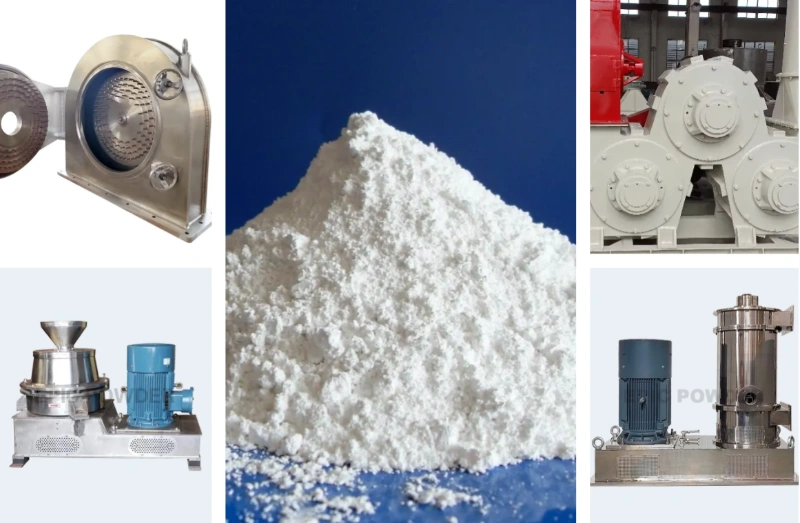Surfactants significantly affect the agglomeration behavior of powder. They change the interfacial properties, force balance, and medium environment of powder particles. The specific mechanism can be divided into five aspects:

Adsorption Modification and Surface Energy Reduction
Surfactants adsorb onto powder surfaces. This lowers surface energy and suppresses powder agglomeration. The mechanisms include:
Hydrophobic Group Anchoring: Hydrophobic groups bind to the surface. Hydrophilic groups orient towards the medium. This forms a directional adsorption layer. It reduces van der Waals attraction between particles.
Charge Regulation: Ionic surfactants (e.g., SDS) charge the powder surface. This enhances electrostatic repulsion. For example, anionic surfactants increase the Zeta potential of ultrafine calcium carbonate. This boosts repulsive forces between particles.
Surface Wettability Optimization: Non-ionic surfactants (e.g., PEG, Tw-80) adsorb via hydrogen bonds. They form a hydrophilic protective layer. This improves powder wettability in the liquid phase. It reduces capillary forces during drying and prevents hard agglomeration.

Steric Hindrance and Micelle Stabilization
Polymer Chain Barrier: Polymer surfactants (e.g., PVA) form extended chains on the surface. These chains prevent particles from approaching through entropic repulsion.
Micelle Encapsulation: When surfactant concentration exceeds the critical micelle concentration (CMC), micelles form. These micelles encapsulate particles, isolating them. This prevents direct contact. For example, micelles in microemulsion methods limit nanoparticle growth and prevent agglomeration.
Suppressing Capillary Forces during Drying
During drying, surfactants reduce agglomeration caused by liquid bridges. The mechanisms include:
Pore Structure Regulation: Surfactants adsorb on the inner surfaces of powder pores. They alter pore structure and size distribution. This lowers capillary pressure. Experiments show that surfactants make the pore size distribution of aluminum hydroxide powders more uniform. This decreases capillary forces and reduces agglomeration.
Solvent Replacement: Non-polar surfactants (e.g., tert-butanol) replace water molecules. This reduces hydrogen bonding. After vacuum freeze-drying, powder dispersion can reach 91.2%.
Type- and Structure-specific Effects
Different surfactants have significantly different inhibitory effects on agglomeration due to differences in chemical structure:
| Type | Representative substances | Function characteristics | Applicable scenarios |
| Anionic | SDS, sodium dodecyl sulfate | Enhances electrostatic repulsion, suitable for aqueous systems. Excessive use may aggravate agglomeration due to electrolyte effect | Calcium carbonate, ceramic slurry |
| Nonionic | PEG, TW-80 | Steric hindrance is the main factor, acid and alkali resistance: high adsorption stability at high temperature | High temperature drying, biocompatible system |
| Cationic | CTAB | Easy to adsorb negatively charged particles, but may cause flocculation due to charge neutralization | Specific oxide powder (such as YMn:O:) |
| Compound system | SDS+PEG | Synergistic effect: dual stability of electrostatic and steric hindrance, and the dispersion effect is better than that of a single component | High solid content slurry, nano powder redispersion |
For example, hydroxyapatite (HAP) modified with citric acid (chelating agent) forms spherical uniform particles, while nonylphenol polyoxyethylene ether reduces the stability of HAP.
Dynamic Process Control and Process Adaptability
Drying Rate Matching: The migration speed of surfactants must match the drying rate. During fast drying, wetting agents (e.g., alkynediol) can promote uniform distribution at the particle interface.
Environmental Responsiveness: pH-sensitive surfactants (e.g., polyacrylamide) become protonated and lose effectiveness in acidic environments. pH buffers are needed for compatibility.
Optimization Strategies and Key Parameters
The core of surfactant inhibition of powder agglomeration lies in reducing surface energy, introducing repulsive forces, and regulating interface structure. In practical applications, the following factors must be considered:
Selection Matching: Choose surfactants with appropriate HLB values based on powder polarity (hydrophilic/hydrophobic).
Concentration Control: Surfactant concentration should exceed the CMC to form micelles. However, excess surfactant can lead to bridge flocculation (e.g., polymer dispersants).
Process Synergy: Combine with ultrasonic dispersion and anti-caking agents (e.g., nano-SiO₂) to improve re-dispersibility.
The combination of anionic and non-ionic surfactants can produce a synergistic effect, balancing both electrostatic and steric stability. This approach is an effective solution for overcoming the difficulty of re-dispersing ultrafine powders (e.g., nano-calcium carbonate, barium titanate) after drying.
Epic Powder
Epic Powder, 20+ years of work experience in the ultrafine powder industry. Actively promote the future development of ultra-fine powder, focusing on crushing, grinding, classifying and modification process of ultra-fine powder. Contact us for a free consultation and customized solutions! Our expert team is dedicated to providing high-quality products and services to maximize the value of your powder processing. Epic Powder—Your Trusted Powder Processing Expert !
